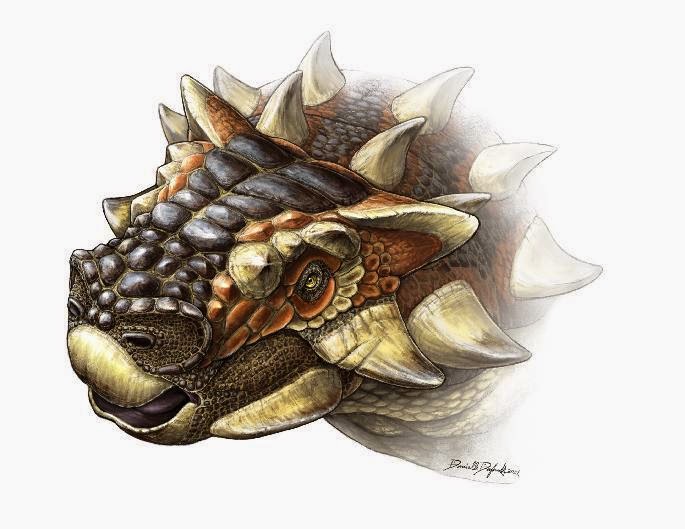
The Gobi Desert of Late Cretaceous Mongolia was the place to be if you were one of the armoured dinosaurs called ankylosaurs. Besides the badlands of southern Alberta, the Gobi Desert has the highest number of ankylosaur species that lived together at the same time—and now a new family member has just been identified.
The new species, Zaraapelta nomadis, was discovered in 2000 by a team led by Phil Currie, and is named today in a paper by Victoria Arbour, Demchig Badamgarav and Philip Currie published in the Zoological Journal of the Linnean Society. The name Zaraapelta is a combination of the Mongolian and Greek works for “hedgehog” and “shield” in reference to its spiky appearance, and “nomadis” in honour of the Mongolian company Nomadic Expeditions, which has facilitated paleontological fieldwork in the Gobi Desert for almost two decades.
Zaraapelta is known from a well-preserved skull that is missing the front of the snout. Like some of the other ankylosaurs from the Gobi Desert, the top of its skull was bumpy and spiky. Zaraapelta is even more ostentatious than the other Mongolian ankylosaurs, with an elaborate pattern of bumps and grooves behind the eye. At the back of its skull there are distinctive horns with a prominent ridge along the top. The skull is part of the collections of the Mongolian Paleontological Center in Ulaanbaatar.
Arbour says the elaborate and distinctive ornamentation on the skulls of Saichania, Tarchia and Zaraapelta may have evolved as a way to show off to members of the opposite sex. It has long been thought that other kinds of dinosaurs, like the crested hadrosaurs or ceratopsians with their horns and frills, used these ornaments during sexual displays, but the idea hasn’t been applied to ankylosaurs.

“You can think of bone as being an expensive item for your body to maintain,” she explains. “Bone requires a lot of nutrients and metabolic energy to create, and so that investment needs to pay off in some way. Maybe ankylosaurs had this bumpy ornamentation for protection, but another good explanation is that the horns and bumps on their skulls showed that they were a good mate to choose, in the same way that male peacocks use their tail feathers.”
Arbour’s history-making PhD research on ankylosaurs has earned her a reputation as the go-to person on the intricacies of their anatomy, lifestyle and growing family tree. She has studied the armoured, club-tailed plant-eaters for the last eight years and has taught paleobiology to students around the globe as one of the instructors for Dino 101, the U of A’s first massive open online course.
Resurrecting a discarded dinosaur
In addition to naming the new ankylosaur Zaraapelta, this study also re-examined previously named ankylosaurs from Mongolia and found support for “resurrecting” a species that had been discarded by earlier workers. The science of naming organisms, called taxonomy, is more fluid than many people might realize, Arbour notes. Sometimes, researchers might determine that two species names represent only one actual species, in which case the name that was created first has priority. This was the case for an ankylosaur called Tarchia kielanae, which was eventually thought to be the same kind of ankylosaur as Tarchia gigantea. But new information from recent dinosaur discoveries, including this study, suggests that Tarchia kielanae might be a separate species after all, so the name has been brought back into use.
Note : The above story is based on materials provided by University of Alberta










